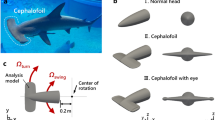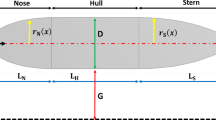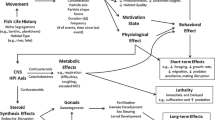Abstract
This paper describes a series of experiments designed to measure the effect of exposure to a full-scale, vertical axis hydrokinetic turbine on downstream migrating juvenile Atlantic salmon (N = 175) and upstream migrating adult American shad (N = 208). Controlled studies were performed in a large-scale, open-channel flume, and all individuals approached the turbine under volitional control. No injuries were observed, and there was no measurable increase in mortality associated with turbine passage. Exposure to the turbine elicited behavioral responses from both species, however, with salmon passing primarily over the downrunning blades. Shad movement was impeded by the device, as indicated by fewer attempts of shorter duration and reduced distance of ascent up the flume. More work should be performed in both laboratory and field conditions to determine to what extent these effects are likely to influence free-swimming fish.








Similar content being viewed by others
References
Allison, P.D. 1995. Survival analysis using the SAS system: A practical guide. Cary: SAS Institute.
Bell, C.E., and B. Kynard. 1985. Mortality of adult American shad passing through a 17-megawatt Kaplan turbine at a low-head hydroelectric dam. North American Journal of Fisheries Management 5: 33–38.
Bickford, S.A., and J.R. Skalski. 2000. Reanalysis and interpretation of 25 years of snake—Columbia River juvenile salmonid survival studies. North American Journal of Fisheries Management 20(200): 53–68.
Burrows, T.E., and H.H. Chenoweth. 1970. The rectangular circulating rearing pond. The Progressive Fish Culturist 32: 67–80.
Castro-Santos, T. 2005. Optimal swim speeds for traversing velocity barriers: an analysis of volitional high-speed swimming behavior of migratory fishes. Journal of Experimental Biology 208:421–432.
Castro-Santos, T., A. Cotel, and P.W. Webb. 2009. Fishway evaluations for better bioengineering—An integrative approach. In Challenges for diadromous fishes in a dynamic global environment, ed. A.J. Haro et al., 557–575. Bethesda: American Fisheries Society, Symposium 69.
Castro-Santos, T., and A. Haro. 2003. Quantifying migratory delay: A new application of survival analysis methods. Canadian Journal of Fisheries and Aquatic Sciences 60: 986–996.
Castro-Santos, T., and A. Haro. 2009. Fish guidance and passage at barriers. In Fish locomotion: An etho-ecological approach, ed. P. Domenici and R.W. Blake. Enfield: Science Publishers.
Castro-Santos, T., A. Haro, and S. Walk. 1996. A passive integrated transponder (PIT) tagging system for monitoring fishways. Fisheries Research 28: 253–261.
Castro-Santos, T., and B.H. Letcher. 2010. Modeling migratory bioenergetics of Connecticut River American shad (Alosa sapidissima): Implications for the conservation of an iteroparous anadromous fish. Canadian Journal of Fisheries and Aquatic Sciences 67: 806–830.
Castro-Santos, T. and Perry, R.W. 2012. Time-to-event analysis as a framework for quantifying fish passage performance. In Telemetry Techniques. Edited by N.S.Adams, J.W.Beeman, and J.Eiler. American Fisheries Society, Bethesda, MD. pp. 427–452.
Electric Power Research Institute. 2011. Evaluation of fish injury and mortality associated with hydrokinetic turbines. Palo Alto: EPRI.
Ferguson, J.W., R.F. Absolon, T.J. Carlson, and B.P. Sandford. 2006. Evidence of delayed mortality on juvenile Pacific salmon passing through turbines at Columbia River dams. Transactions of the American Fisheries Society 135: 139–150.
Haro, A., T. Castro-Santos, J. Noreika, and M. Odeh. 2004. Swimming performance of upstream migrant fishes in open-channel flow: A new approach to predicting passage through velocity barriers. Canadian Journal of Fisheries and Aquatic Sciences 61: 1590–1601.
Harris, J.E., and J.E. Hightower. 2012. Demographic population model for American shad: Will access to additional habitat upstream of dams increase population sizes? Marine and Coastal Fisheries 4: 262–283.
Hosmer, D.W., and S. Lemeshow. 1989. Applied logistic regression. New York: Wiley.
Hosmer, D.W., and S. Lemeshow. 1999. Applied survival analysis. New York: Wiley.
Kaplan, E.L., and P. Meier. 1958. Nonparametric estimation from incomplete observations. Journal of the American Statistical Association 53: 457–481.
Larinier, M., and F. Travade. 2002. The design of fishways for shad. Bulletin Francais de la Peche et de la Pisciculture 135–146.
McCormick, S.D., L.P. Hansen, T.P. Quinn, and R.L. Saunders. 1998. Movement, migration, and smolting of Atlantic salmon (Salmo salar). Canadian Journal of Fisheries and Aquatic Sciences 55: 77–92.
McCormick, S.D., D.T. Lerner, M.Y. Monette, K. Nieves-Puigdoller, J.T. Kelly, and B.T. Bjornsson. 2009. Taking it with you when you go: How perturbations to the freshwater environment, including temperature, dams, and contaminants, affect marine survival of salmon. Challenges for Diadromous Fishes in A Dynamic Global Environment 69: 195–214.
McLaughlin R.L., E.R.B. Smyth, T. Castro-Santos, M.L. Jones, M.A. Koops, T.C. Pratt, and L.A. Vélez-Espino. 2012. Unintended consequences and trade-offs for fish passage. Fish and Fisheries. doi:10.1111/faf.12003.
Normandeau Associates, Inc. 2009. An estimateion of survival and injury of fish passed through the Hydro Green Energy hydrokinetic system, and an characterization of fish entrainment potential at the Mississippi Lock and Dam No. 2 hydroelectric project (P-4306), Hastings, Minnesota—Final report. Drumore: Normandeau Associates, Inc.
Odeh, M. 1999. A summary of environmentally friendly turbine design concepts. DOE/ID/13741. Idaho Falls: US Department of Energy, Idaho Operations Office.
Perry, R.W., T. Castro-Santos, C.M. Holbrook, and B.P. Sandford. 2012. Using mark–recapture models to estimate survival from telemetry data. In Telemetry techniques: A user guide for fisheries research, ed. N.S. Adams, J.W. Beeman, and J. Eiler, 453–476. Bethesda: American Fisheries Society.
Skalski, J.R. 1998. Estimating season-wide survival rates of outmigrating salmon smolts in the Snake River, Washington. Canadian Journal of Fisheries and Aquatic Sciences 55: 761–769.
Skalski, J.R., J. Lady, R. Townsend, A.E. Giorgi, J.R. Stevenson, C.M. Peven, and R.D. McDonald. 2001. Estimating in-river survival of migrating salmonid smolts using radiotelemetry. Canadian Journal of Fisheries and Aquatic Sciences 58: 1987–1997.
Sprankle, K. 2005. Interdam movements and passage attraction of American shad in the lower Merrimack River main stem. North American Journal of Fisheries Management 25: 1456–1466.
Stier, D.J., and B. Kynard. 1986. Use of radio telemetry to determine the mortality of Atlantic salmon smolts passed through a 17-MW Kaplan turbine at a low-head hydroelectric dam. Transactions of the American Fisheries Society 115: 771–775.
Sullivan, T.J. 2004. Evaluation of the Turner’s Falls fishway complex and potential improvements for passing adult American shad. M.S. thesis, University of Massachusetts, Amherst.
Acknowledgments
This work was supported by funding from the US Department of Energy, Canada Department of Fisheries and Oceans (DFO), Alaska Fish and Game and NewEnergy Corp. Special thanks to Steve Walk and John Noreika (USGS Conte Lab); Amy Teffer and Melissa Belcher (University of Massachusetts Amherst); Paul Jacobson (Electric Power Research Institute), Bruce Hannah (DFO); and Bob Moll (New Energy Corp.).
Disclaimer
Any use of trade, product, or firm names is for descriptive purposes only and does not imply endorsement by the U.S. Government.
Author information
Authors and Affiliations
Corresponding author
Additional information
Communicated by Wayne S. Gardner
Rights and permissions
About this article
Cite this article
Castro-Santos, T., Haro, A. Survival and Behavioral Effects of Exposure to a Hydrokinetic Turbine on Juvenile Atlantic Salmon and Adult American Shad. Estuaries and Coasts 38 (Suppl 1), 203–214 (2015). https://doi.org/10.1007/s12237-013-9680-6
Received:
Revised:
Accepted:
Published:
Issue Date:
DOI: https://doi.org/10.1007/s12237-013-9680-6




